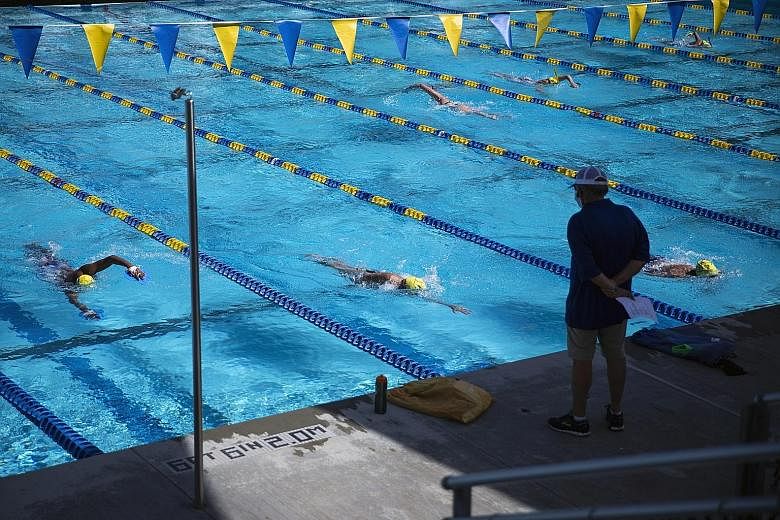NEW YORK • The 18 swimmers entered the outdoor pool deck in a procession, taking care to stay over 3m apart from one another. On the walk to their individually assigned lanes, the Mission Viejo Nadadores team members glanced at the giant scoreboard.
On the screen their coach, Mark Schubert, had keyed in a message: "May the new normal teach us to be grateful for the things the old normal taught us to take for granted."
Across the United States and throughout the world, sports are slowly awakening from their two-month respite during the coronavirus pandemic.
As countries start to ease lockdown restrictions aimed at stemming the spread of the contagion, football teams in Germany, Spain and Italy have resumed training in the hopes of resuming their seasons; professional golfers are eyeing a late spring return to competition; and touring tennis professionals learned this week that an altered version of a season is in the works.
Pro baseball began again in South Korea on Tuesday, some National Basketball Association training facilities opened yesterday, and the Ultimate Fighting Championship and Nascar plan to hold events this month without fans on-site.
But the sports world is a many-tentacled behemoth, and its return to life is characterised by uneven circumstances. While golfers living in some parts of the United States have had largely uninterrupted access to courses, counterparts in other states or in other countries, like Britain, have been reduced, at best, to hitting wedge shots into netting in their backyards.
In the United States, 50 states may produce 50 different sets of regulations. Athletes in some European and Asian countries may have a hard time travelling elsewhere. The different guidelines and realities, depending on geography, complicate each athlete's efforts to get back into competitive shape.
As such, any psychological benefits of bringing back sports must be weighed against the potential physical harm.
In an interview last week, Dr Jonathan Finnoff, the chief medical officer for the United States Olympic & Paralympic Committee (USOPC), said that as restrictions are reduced, "there will be a potential for outbreaks, and we have to anticipate that will happen".
Those fears gained traction in Germany this week when 10 players from the country's football league were found to have the virus after blanket testing of 1,724 individuals.
Anton Olsson, a Swede who captains a third-division team in Orebro, his home town, has watched other countries ease their restrictions with growing unease.
"It's frustrating," said Olsson, whose team continued to train during the pandemic in accordance with Sweden's looser restrictions.
He described three or four people on his club, including a coach, who have been sick with coronavirus symptoms and added, "Everyone on the team should have had it or are going to have it."
In guidelines issued last week by the USOPC, Dr Finnoff said that the public health authorities must say it is safe for small groups to gather before any training may occur at public facilities.
Even then, the guidelines say, training should not be conducted as usual. Initially, athletes should socially distance, use their own equipment and wash any shared equipment with antiseptic cleaners. They should also wear facial coverings and avoid direct contact with other athletes - so, no contact sports.
A tennis player can hit alone, but not with another player, who might wipe away sweat on her face then pick up the shared ball. A basketball player can shoot but not pass.
If competitive sports do resume, they will almost certainly be contingent on widespread testing and fewer people interacting.
The Ladies' Professional Golf Association, which has made plans to restart its season in July, circulated an e-mail to players and caddies that said not to expect fans at its first few events.
This week, World Team Tennis announced plans to bring its nine teams to a single venue, and to play this year's schedule, tentatively starting in July, with a revamped format.
For Mission Viejo's Katie Crom, 16, she is glad to be back swimming, and not just for the exercise.
"It is really great to see my friends again, even at a distance," she said in a text message. "That is something we took for granted."
Crom and her teammates arrive wearing their suits, since the locker rooms remain closed, and enter the pool deck from the parking lot one at a time. They do not stray from the middle of the lanes as they complete 75-minute workouts that are written on paper and affixed to the end of each 25-yard lane set up across the width of the 50m competition pool.
Schubert wears a surgical mask and stands far enough away but Crom said, "we can barely hear him".
If the swimmers have to use the bathroom, they must trek up a hill to the single toilets at the swim school, and they are required to sanitise afterwards. "Nobody has asked to go to the bathroom," he said. "I think because nobody wants to clean the toilets."
Or perhaps, as Crom suggested, after being kept out of the pool for so long, nobody wants to miss a single minute in the water.
"Before the quarantine we took everything for granted," she said, adding, "Swimming in a pool and lake was always available since I was a child. I never thought that water would be restricted."
NYTIMES

